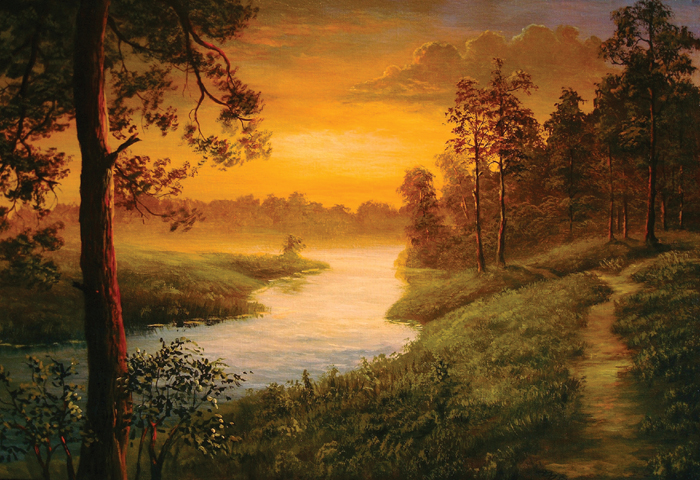68. People React to Beauty
There has actually been research on the idea of beauty and aesthetics. It seems like a hard topic to do research on, but it’s possible.
Pastoral Scenes Make People Happy
Walk into any hotel, house, office building, museum, art gallery, or other place where there are paintings or photographs hanging on the wall, and chances are that you’ll see a picture that looks something like Figure 68.1.
Figure 68.1. Pastoral scenes are part of our evolution. (Evening at the River by Stanislav Pobytov)
According to Denis Dutton, a philosopher and the author of The Art Instinct: Beauty, Pleasure, and Human Evolution, this is because of evolution and the Pleistocene era. (See Dutton’s TED talk at http://bit.ly/cIj9uo.) Dutton notes that typical landscape scenes include hills, water, trees (good for hiding in if a predator comes by), birds, animals, and a path moving through the scene. This is an ideal landscape for humans, containing protection, water, and food. Dutton’s theory about beauty is that we have evolved to feel a need for certain types of beauty in our life, and that this pull toward things such as these landscapes has helped us to survive as a species. He notes that all cultures value artwork that has these scenes, even people who have never lived in a geographical location that looks like this.
Pastoral Scenes Provide “Attention Restoration”
Mark Berman (2008) and a team of researchers had participants perform the backward digit-span task, which measures a person’s capacity to focus attention. Next, participants were asked to do a task that would wear out their voluntary attention. After that, some walked through downtown Ann Arbor, Michigan, and some walked through the city’s arboretum. The arboretum has trees and wide lawns (that is, it is a pastoral environment). Following the walk, the participants did the backward digit-span task again. Scores were higher for the people who had walked through the arboretum. Stephen Kaplan (one of the researchers) calls this attention restoration therapy.
Roger Ulrich (1984) found that patients whose hospital windows overlooked scenes of nature had shorter stays in the hospital and needed less pain medication than patients whose rooms looked onto a brick wall.
Peter Kahn and his team (Kahn, Severson, and Ruckert, 2009) tested nature scenes in the workplace. One group of participants worked in an office where they sat near a window that overlooked a nature scene. A second group saw a similar scene, but not out the window; instead, they watched a video feed from a nature area outside. A third group sat near an empty wall. The researchers kept measurements of the participants’ heart rates to monitor their stress levels.
People who saw the video scene said that they felt better, but their heart rates were actually no different from those who sat next to the wall. People in front of the window actually had healthier heart-rate measurements and were better able to recover from stress.
People React to the Aesthetics of Slides
The concept of beauty applies to screens and slides as well. Lavie and Tractins (2004) studied the factors that make people feel that a Web site is aesthetically pleasing. Although they were studying Web sites, much of their work applies to any screen. They found that there were two broad clusters of factors that made people feel that a particular screen was aesthetically pleasing: the amount of order and clarity, and the amount of originality.
![]() Learn more about designing aesthetically pleasing slides
Learn more about designing aesthetically pleasing slides
If you want to learn more about aesthetic design, check out these two great books:
Presentation Zen by Garr Reynolds (New Riders, 2008), and The Principles of Beautiful Web Design by Jason Beaird (SitePoint, 2007). Even though the latter has Web design in its title, much of the book has to do with the layout of a single screen, which applies to the design of slides.

